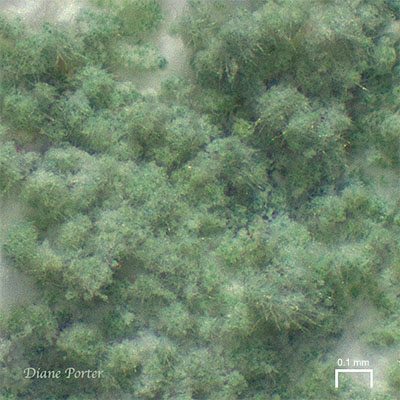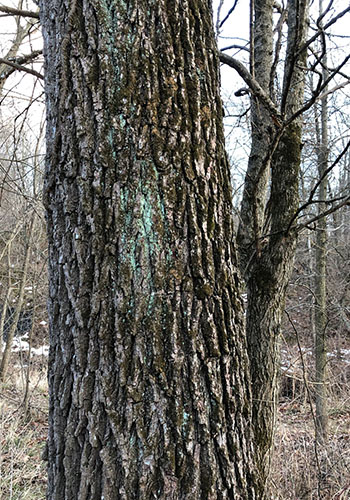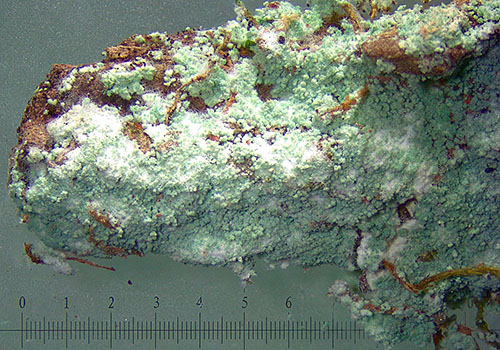Fink's Fluffy Dust Lichen
Lepraria finkii

It looks rather like the sky's view of a misty, snow-flocked forest. I see trees with branches and a leaf-thick canopy, with clearings between.
But you would have to be very small to see it. You could cover everything in this photo with a dot from a felt-tip writing pen. (That little scale in the lower-right corner is 1/10 of a millimeter wide.)
When I first walked past the big Black Walnut tree, I saw only a cottony turquoise fluffiness against the trunk. When I learned that its common name is Fluffy Dust Lichen, I thought that was perfect.
Scientific name
But an even better surpise was in store for me when I learned its scientific name: Lepraria finkii. It is named for the great lichenologist Bruce Fink, who did much of his work in my home state of Iowa.
The other part of the scientific name, Lepraria, means "leprose." It refers to the fact that the entire body of the lichen is made up microscopic particles, called soredia. These soredia have all the DNA of both the fungal partner and the photosynthesizing partner. One particle of the soredia, carried away by air or water, can start a new growth of this lichen in a new location.

There is some difference of opinion on the name of this lichen. In the great Brodo book Lichens of North America, it is refrred to as Lepraria lobificans. Ultimately the name settled on L. finkii, and I am pleased with that. It's part of what makes this lichen feel like a personal friend.
At home in the woods
Whenever I walk the path down along Crow Creek, I find myself checking out the big Black Walnut tree where I first found the Lepraria. It seems almost magical, always brighter than I expect in the shade of the woods. As if the trunk has been splashed with paint by someone planning to redo the bedroom.
Now I'm finding Fluffy Dust Lichen on many species of trees down in that Oxbow of Crow Creek. On hawthorns, locusts, and box elders. The lichen seems not to be particular about the species of its substrate.
I'm only guessing what are this lichen's requirements. I don't find it just anywhere. Only close to the creek, in areas sheltered by the canyon the creek has cut. So it must like moisture, and perhaps some protection from sunlight. But I know I've only begun to know Leparia finkii.
One day I murmured an apology, pried off a small chip of turquoise bark, and brought it home to look at under the microscope. Then I started see the features of this lichen. Magnified, it looks like the view a migrating bird might have, looking down at a patch of woods and considering whether it would be worth landing there.

And I'm wondering if there might be a whole ecosystem in that lichen, of life forms too small to be seen even with my microscope. Invertebrate organisms living their lives, finding food, feeding other life forms, reproducing in ways I can scarcely imagine. They must be playing roles undreamed of in the wonder that is life on planet Earth.
In the photo the scale shows millimeters numbered. The smallest divisions are 0.1 millimeters.
— Diane Porter, Fairfield, Iowa, March 6, 2022

